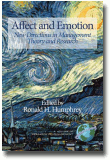
Affect and Emotion
New Directions in Management Theory and Research
Edited by:
Ronald H. Humphrey, Virginia Commonwealth University
A volume in the series: Research in Management. Editor(s): Timothy Ewest, Houston Baptist University.
Published 2008
Affect and Emotion includes a variety of chapters by some of the most prominent scholars in the area of emotions and leadership, as well as chapters by rising stars. These chapters chart the direction of future research in affect and leadership in four main areas. First, several of these chapters make a convincing argument that leaders use emotional labor and other forms of emotional displays to influence followers and team members. Leaders may use emotional labor to manage relational identities, or to create favorable impressions on followers and to create trust. Leaders' active emotional displays increase vision related performance and perception of transformational leadership.
Second, one chapter reveals how emotions play an important role in leadership at every level, from within-person to organization-wide leadership. Leader's emotional labor plays an important role in several of these levels, with the exact method of performing emotional labor varying by level. A second chapter also examines levels of leadership, with a particular examination of the effects of leader emotional labor on close and distant leadership. Third, several of the chapters examine emotions from the authentic leadership and positive leadership perspectives, and two of these chapters focus on how psychological capital and authentic leadership skills help leaders be resilient and overcome obstacles. Fourth, two of the chapters show the role of affect and friendship ties to leadership research. One of these chapters examines the need to develop psychometrically sound measures of affect and friendship, whereas the other develops a model of how affect influences social network ties and informal leadership emergence. Taken together, these chapters illustrate four important research trends in emotions and leadership that are likely to grow in importance in the coming years.
CONTENTS
Introduction to the Research in Management Series, Chester A. Schriesheim and Linda L. Neider. Foreword: To Thine Own Self Be True: How Great Scholars Become Innovative by Expressing their True Selves, Ronald H. Humphrey. The Right Way to Lead with Emotional Labor, Ronald H. Humphrey. A Multi-level View of Leadership and Emotion, Neal M. Ashkanasy and Peter J. Jordan. Leader Emotional Displays from Near and Far: The Implications of Close versus Distant Leadership for Leader Emotional Labor and Authenticity, James G. (Jerry) Hunt, William L. Gardner, and Dawn Fischer. Leader Emotions and Vision Implementation: Effects of Activation Potential and Valence, Ethan P. Waples and Shane Connelly. A Cognitive Affective Processing Explanation of Positive Leadership: Toward Theoretical Understanding of the Role of Psychological Capital, Sean T. Hannah and Fred Luthans. Authentic Leadership and Follower Emotional Reactions to Major Obstacles at Work, Yongmei Liu, Weichun Zhu, and Pamela L. Perrewé. Development and Preliminary Assessment of Short Scales to Measure Affect and Friendship in Leadership Research, Chester A. Schriesheim and Linda L. Neider. Affective Events: Building Social Network Ties and Facilitating Informal Leader Emergence, Paul D. Johnson and Marie T. Dasborough.
-
Paperback978-1-59311-959-1
Web price: $45.04 (Reg. 52.99)
-
Hardcover978-1-59311-960-7
Web price: $80.74 (Reg. 94.99)
- eBook9781607528159

- BUS071000 - BUSINESS & ECONOMICS: Leadership
- BUS041000 - BUSINESS & ECONOMICS: Management
- BUS030000 - BUSINESS & ECONOMICS: Human Resources & Personnel Management








